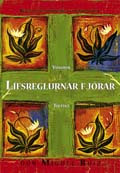20.6.2008 | 13:56
Yfir 1000 Tíbetar horfnir
Samkvćmt AI hafa yfir 1000 Tíbetar horfiđ síđan mótmćli brutust út í mars. Fleiri ţúsund manns eru í haldi og tölur látinna vaxa stöđugt. Vinir Tíbets hittast fyrir utan kínverska sendiráđiđ á morgunn laugardaginn 21. júní klukkan 13. Markmiđiđ er ađ sýna Tíbetum stuđning í verki á međan fariđ verđur međ kyndilinn í gegnum landiđ ţeirra án vilja ţjóđarinnar. Fólki er gert ađ halda sig innandyra og horfa á ţetta í sjónvarpinu. Krafa okkar er hin sama og áđur. Ađ landiđ verđi opnađ fyrir alţjóđafjölmiđlum sem og mannréttindasamtökum.
Lćt fylgja međ frétt sem ég var ađ lesa frá Phayul...
| Tensions are High as the Olympic Torch Arrives in Lhasa | ||
|

|
Ólympíueldurinn á leiđ til höfuđborgar Tíbets |
| Tilkynna um óviđeigandi tengingu viđ frétt | |
Flokkur: Stjórnmál og samfélag | Facebook
Tenglar
Nýja Ísland
Ég les:
Tíbet
- Fréttir frá Tibet
- Tibet Info Net An Independent Information Service on Contemporary Tibet
- Undercover in Tibet Ný heimildarmynd frá Channel 4 um hvernig ástandiđ er í raun og veru í Tíbet
- Leaving Fear Behind Viđtöl viđ Tíbeta í Tíbet stuttu fyrir mótmćlin í mars
- Cry of the Snow Lion Margverđlaunuđ heimildarmynd um Tíbet
- Yeti - heimildarmynd
- Yogis of Tibet Heimildarmynd um Jógameistara Tíbets sem eru óđum ađ hverfa
- Students for a Free Tibet
- Dalai Lama
- Tibetan Uprising
- Kerti fyrir Tíbet
- Tibet TV
- Central Tibetan Administration
- Om mani padme hum
Ýmsar slóđir
sem ég man eftir í andartakinu
- The Hunger Site
- THE MEATRIX
- Myspace síðan mín
- Úgáfan Beyond Borders Alţjóđleg útgáfa sem ég stofnađi áriđ 1999 í netheimum
- Hitt bloggið mitt
- Félagið Ísland-Palestína
- Womb of Creation Vefurinn minn sem ég hef haldiđ viđ síđan 1995
- Myspace síðan hennar mömmu
- Saving Iceland
- Be the change:)
- Náttúra vefur međ umhverfisvitund
- Nattura info
- Care 2 make a Difference
Bćkur
Bćkurnar mínar
-

: Tuttugasta öldin og lćrdómar hennar (ISBN: 9979-772-77-8 )
Ţýddi ţessa ásamt Jóni Karli Stefánssyni -

: Lífsreglurnar fjórar - the Four Agreements (ISBN: 9979768835)
Lífsreglurnar fjórar er ćvaforn indjánaspeki sem hefur fariđ sigurför um heiminn. Bókin er byggđ á fornri visku Tolteka-indjána og útskýrir sannindi sem er ađ finna í helgum dulspekihefđum víđsvegar um heim. Lesanda eru kynntar fjórar einfaldar en magnađar lífsreglur sem vísa leiđina ađ frelsi og sjálfstćđi einstaklingsins. Höfundurinn, don Miguel Ruiz, er af ćtt grćđara og seiđmanna sem hafa iđkađ Toltekafrćđin frá aldaöđli. Hann er heimsţekktur fyrir bćkur sínar og fyrirlestra. -

: Dagbók kameljónsins (ISBN: 9979973307)
Dagbók kameljónsins er ţroskasaga stúlku sem hefur ţurft ađ berjast viđ ađ sogast ekki inn í geđveiki ćttmenna sinna, en sjálfsvíg ţeirrar manneskju sem hún leit á sem klettinn í lífi sínu verđur til ţess ađ hún gerir sér ljóst hve dýrmćtt lífiđ er. Međ ţví ađ ţvinga sig til ađ muna fortíđina skapar hún möguleika á ađ eiga sér einhverja framtíđ. Alkóhólismi móđur hennar vegur jafnframt ţungt í ţessu verki og hefur afgerandi áhrif á sjálfmeđvitund söguhetjunnar sem á endanum öđlast ţroska til ađ sjá manneskjuna handan sjúkdómsins sem brýst oft út í mikilli sjálfhverfu ţess sem er haldin honum og skilur ađra fjölskyldumeđlimi eftir međ ţví sem nćst ósýnilegan geđrćnan sjúkdóm sem jafnan er kenndur viđ međvirkni. En ţetta er engin venjuleg bók, hún er brimfull af von og lausnum, ćvintýrum og einlćgni og fellur aldrei inn í pytt sjálfsvorunnar. Bókin er tilraun til ađ brúa biliđ á milli ţess myndrćna sem oft fyrirfinnst í dagbókum, en formiđ bíđur upp á vćgđarlausan heiđarleika og gefur lesandanum tćkifćri á ađ nota sitt eigiđ hugarflug.
Heimsóknir
Flettingar
- Í dag (3.10.): 0
- Sl. sólarhring:
- Sl. viku: 9
- Frá upphafi: 0
Annađ
- Innlit í dag: 0
- Innlit sl. viku: 7
- Gestir í dag: 0
- IP-tölur í dag: 0
Uppfćrt á 3 mín. fresti.
Skýringar
Tónhlađa
Bloggvinir
-
 ADHD
ADHD
-
 Agný
Agný
-
 Alfreð Símonarson
Alfreð Símonarson
-
 Andrea J. Ólafsdóttir
Andrea J. Ólafsdóttir
-
 Alexandra Briem
Alexandra Briem
-
 Andrés Magnússon
Andrés Magnússon
-
 Anna Ragna Alexandersdóttir
Anna Ragna Alexandersdóttir
-
 Anna Ólafsdóttir Björnsson
Anna Ólafsdóttir Björnsson
-
 Ari Sigurðsson
Ari Sigurðsson
-
 Baldvin Björgvinsson
Baldvin Björgvinsson
-
 Baldvin Jónsson
Baldvin Jónsson
-
 Baldvin Jónsson
Baldvin Jónsson
-
 Bara Steini
Bara Steini
-
 Bergur Sigurðsson
Bergur Sigurðsson
-
 Bergur Thorberg
Bergur Thorberg
-
 Bergur Þór Ingólfsson
Bergur Þór Ingólfsson
-
 Bergþóra Árnadóttir - RIP 15.2.48 - 8.3.07
Bergþóra Árnadóttir - RIP 15.2.48 - 8.3.07
-
 Binnan
Binnan
-
 Birgir Þórarinsson
Birgir Þórarinsson
-
 Birna Rebekka Björnsdóttir
Birna Rebekka Björnsdóttir
-
 Bjargandi Íslandi
Bjargandi Íslandi
-
 Bjarkey Gunnarsdóttir
Bjarkey Gunnarsdóttir
-
 Björgvin R. Leifsson
Björgvin R. Leifsson
-
 SVB
SVB
-
 Brjánn Guðjónsson
Brjánn Guðjónsson
-
 Brosveitan - Pétur Reynisson
Brosveitan - Pétur Reynisson
-
 Bryndís Ísfold Hlöðversdóttir
Bryndís Ísfold Hlöðversdóttir
-
 Brynja skordal
Brynja skordal
-
 Brynjar Hólm Bjarnason
Brynjar Hólm Bjarnason
-
 Bókaútgáfan Salka ehf
Bókaútgáfan Salka ehf
-
 Dagrún Steinunn Ólafsdóttir
Dagrún Steinunn Ólafsdóttir
-
 Daníel Haukur
Daníel Haukur
-
 Dorje
Dorje
-
 Dísa Dóra
Dísa Dóra
-
 Egill Bjarnason
Egill Bjarnason
-
 Egill Jóhannsson
Egill Jóhannsson
-
 Einar Guðjónsson
Einar Guðjónsson
-
 Einar Indriðason
Einar Indriðason
-
 Einar Vignir Einarsson
Einar Vignir Einarsson
-
 Einar Ólafsson
Einar Ólafsson
-
 Eiríkur Bergmann Einarsson
Eiríkur Bergmann Einarsson
-
 Eldur Ísidór
Eldur Ísidór
-
 Elyas
Elyas
-
 Elín Sigurðardóttir
Elín Sigurðardóttir
-
 Elísabet Markúsdóttir
Elísabet Markúsdóttir
-
 Erna Friðriksdóttir
Erna Friðriksdóttir
-
 Erna Hákonardóttir Pomrenke
Erna Hákonardóttir Pomrenke
-
 Eva Benjamínsdóttir
Eva Benjamínsdóttir
-
 Eydís Hentze Pétursdóttir
Eydís Hentze Pétursdóttir
-
 Eyjólfur Kristinn Vilhjálmsson
Eyjólfur Kristinn Vilhjálmsson
-
 FLÓTTAMAÐURINN
FLÓTTAMAÐURINN
-
 Finnur Bárðarson
Finnur Bárðarson
-
 Friðrik Hansen Guðmundsson
Friðrik Hansen Guðmundsson
-
 Friðrik Þór Guðmundsson
Friðrik Þór Guðmundsson
-
 Fríða Eyland
Fríða Eyland
-
 Félag Anti-Rasista
Félag Anti-Rasista
-
 Félag um stafrænt frelsi á Íslandi
Félag um stafrænt frelsi á Íslandi
-
 Gaukur Úlfarsson
Gaukur Úlfarsson
-
 Georg P Sveinbjörnsson
Georg P Sveinbjörnsson
-
 Gerður Pálma
Gerður Pálma
-
 Gestur Guðjónsson
Gestur Guðjónsson
-
 Goggi
Goggi
-
 Greta Björg Úlfsdóttir
Greta Björg Úlfsdóttir
-
 Gunnar Pétursson
Gunnar Pétursson
-
 Gunnar Rögnvaldsson
Gunnar Rögnvaldsson
-
 Gunnar Skúli Ármannsson
Gunnar Skúli Ármannsson
-
 Gunnlaugur B Ólafsson
Gunnlaugur B Ólafsson
-
 Gunnlaugur Stefán Gíslason
Gunnlaugur Stefán Gíslason
-
 Guðjón Baldursson
Guðjón Baldursson
-
 Guðjón Bergmann
Guðjón Bergmann
-
 Guðjón Heiðar Valgarðsson
Guðjón Heiðar Valgarðsson
-
 Guðmundur Helgi Helgason
Guðmundur Helgi Helgason
-
 Guðmundur M Ásgeirsson
Guðmundur M Ásgeirsson
-
 Guðmundur Ragnar Guðmundsson
Guðmundur Ragnar Guðmundsson
-
 Guðmundur Steingrímsson
Guðmundur Steingrímsson
-
 Guðmundur Ásgeirsson
Guðmundur Ásgeirsson
-
 Guðný Lára
Guðný Lára
-
 Guðrún S Sigurðardóttir
Guðrún S Sigurðardóttir
-
 Guðsteinn Haukur Barkarson
Guðsteinn Haukur Barkarson
-
 Gísli Hjálmar
Gísli Hjálmar
-
 Haffi
Haffi
-
 Halldór Sigurðsson
Halldór Sigurðsson
-
 Hannibal Garcia Lorca
Hannibal Garcia Lorca
-
 Haukur Már Helgason
Haukur Már Helgason
-
 Heidi Strand
Heidi Strand
-
 Heilsa 107
Heilsa 107
-
 Heiða Þórðar
Heiða Þórðar
-
 Helga Auðunsdóttir
Helga Auðunsdóttir
-
 Kaleb Joshua
Kaleb Joshua
-
 Hildur Helga Sigurðardóttir
Hildur Helga Sigurðardóttir
-
 Himmalingur
Himmalingur
-
 Hilmar Gunnlaugsson
Hilmar Gunnlaugsson
-
 Hjálmtýr V Heiðdal
Hjálmtýr V Heiðdal
-
 Hjörleifur Guttormsson
Hjörleifur Guttormsson
-
 Hlekkur
Hlekkur
-
 Hlynur Hallsson
Hlynur Hallsson
-
 Hlynur Jón Michelsen
Hlynur Jón Michelsen
-
 Hlédís
Hlédís
-
 Hrafnhildur Ýr Vilbertsdóttir
Hrafnhildur Ýr Vilbertsdóttir
-
 Hrannar Baldursson
Hrannar Baldursson
-
 Hrólfur Guðmundsson
Hrólfur Guðmundsson
-
 Hulla Dan
Hulla Dan
-
 Hólmfríður Guðlaug Einarsdóttir
Hólmfríður Guðlaug Einarsdóttir
-
 Hörður B Hjartarson
Hörður B Hjartarson
-
 Húmoristaflokkurinn
Húmoristaflokkurinn
-
 Ingibjörg Álfrós Björnsdóttir
Ingibjörg Álfrós Björnsdóttir
-
 Ingibjörg Helga
Ingibjörg Helga
-
 Ingibjörg SoS
Ingibjörg SoS
-
 Ingibjörg Stefánsdóttir
Ingibjörg Stefánsdóttir
-
 Ingigerður Friðgeirsdóttir
Ingigerður Friðgeirsdóttir
-
 Isis
Isis
-
 Jakob Falur Kristinsson
Jakob Falur Kristinsson
-
 Jakob Smári Magnússon
Jakob Smári Magnússon
-
 Jakob Þór Haraldsson
Jakob Þór Haraldsson
-
 Jakobína Ingunn Ólafsdóttir
Jakobína Ingunn Ólafsdóttir
-
 Jens Guð
Jens Guð
-
 Johann Trast Palmason
Johann Trast Palmason
-
 Jóhannes Ragnarsson
Jóhannes Ragnarsson
-
 Jón Bjarnason
Jón Bjarnason
-
 Jón Gerald Sullenberger
Jón Gerald Sullenberger
-
 Jón Sigurgeirsson
Jón Sigurgeirsson
-
 Jón Svavarsson
Jón Svavarsson
-
 Jón Valur Jensson
Jón Valur Jensson
-
 Jón Þór Ólafsson
Jón Þór Ólafsson
-
 DÓNAS
DÓNAS
-
 Katrín Mixa
Katrín Mixa
-
 Katrín Snæhólm Baldursdóttir
Katrín Snæhólm Baldursdóttir
-
 Ketill Sigurjónsson
Ketill Sigurjónsson
-
 Ketilás
Ketilás
-
 Kjartan Pétur Sigurðsson
Kjartan Pétur Sigurðsson
-
 Konráð Ragnarsson
Konráð Ragnarsson
-
 Kristbergur O Pétursson
Kristbergur O Pétursson
-
 Kristján B. Jónasson
Kristján B. Jónasson
-
 Kristján Kristjánsson
Kristján Kristjánsson
-
 Kristján Logason
Kristján Logason
-
 Kristín Dýrfjörð
Kristín Dýrfjörð
-
 Kristín Snorradóttir
Kristín Snorradóttir
-
 Krummi
Krummi
-
 Kári Harðarson
Kári Harðarson
-
 Landvernd
Landvernd
-
 Laufey Ólafsdóttir
Laufey Ólafsdóttir
-
 Lovísa
Lovísa
-
 Lára Hanna Einarsdóttir
Lára Hanna Einarsdóttir
-
 Lýður Árnason
Lýður Árnason
-
 Mafía-- Linda Róberts.
Mafía-- Linda Róberts.
-
 Margrét Guðjónsdóttir
Margrét Guðjónsdóttir
-
 Margrét Lóa Jónsdóttir
Margrét Lóa Jónsdóttir
-
 Margrét Sigurðardóttir
Margrét Sigurðardóttir
-
 Markús frá Djúpalæk
Markús frá Djúpalæk
-
 María Kristjánsdóttir
María Kristjánsdóttir
-
 María Pétursdóttir
María Pétursdóttir
-
 Methúsalem Þórisson
Methúsalem Þórisson
-
 Morgunblaðið
Morgunblaðið
-
 Myndlistarfélagið
Myndlistarfélagið
-
 Mál 214
Mál 214
-
 Máni Ragnar Svansson
Máni Ragnar Svansson
-
 Neo
Neo
-
 Oddi
Oddi
-
 Paul Nikolov
Paul Nikolov
-
 Perla
Perla
-
 Pjetur Hafstein Lárusson
Pjetur Hafstein Lárusson
-
 Pálmi Gunnarsson
Pálmi Gunnarsson
-
 Pálmi Guðmundsson
Pálmi Guðmundsson
-
 Ragnar Þór Ingólfsson
Ragnar Þór Ingólfsson
-
 Rannveig H
Rannveig H
-
 Ransu
Ransu
-
 Róbert Björnsson
Róbert Björnsson
-
 Rögnvaldur Hreiðarsson
Rögnvaldur Hreiðarsson
-
 Rúnar Sveinbjörnsson
Rúnar Sveinbjörnsson
-
 Rúnar Þór Þórarinsson
Rúnar Þór Þórarinsson
-
 Salvör Kristjana Gissurardóttir
Salvör Kristjana Gissurardóttir
-
 Samstaða - bandalag grasrótarhópa
Samstaða - bandalag grasrótarhópa
-
 SeeingRed
SeeingRed
-
 Sema Erla Serdar
Sema Erla Serdar
-
 Sigga
Sigga
-
 Signý
Signý
-
 Sigrún Jónsdóttir
Sigrún Jónsdóttir
-
 Sigurgeir Orri Sigurgeirsson
Sigurgeir Orri Sigurgeirsson
-
 Sigurgeir Þór Hreggviðsson
Sigurgeir Þór Hreggviðsson
-
 Sigurjón Sigurðsson
Sigurjón Sigurðsson
-
 Sigurður Hrellir
Sigurður Hrellir
-
 Sigurður Sigurðsson
Sigurður Sigurðsson
-
 Sigurður Þór Guðjónsson
Sigurður Þór Guðjónsson
-
 Skuldlaus
Skuldlaus
-
 Snorri Sturluson
Snorri Sturluson
-
 Soffía Valdimarsdóttir
Soffía Valdimarsdóttir
-
 Stefán Friðrik Stefánsson
Stefán Friðrik Stefánsson
-
 Þorsteinn Briem
Þorsteinn Briem
-
 Steinunn Helga Sigurðardóttir
Steinunn Helga Sigurðardóttir
-
 Steinunn Ólína Þorsteinsdóttir
Steinunn Ólína Þorsteinsdóttir
-
 Stríða
Stríða
-
 Sveinbjörn Eysteinsson
Sveinbjörn Eysteinsson
-
 Sveinn Hjörtur
Sveinn Hjörtur
-
 Sveinn Ólafsson
Sveinn Ólafsson
-
 Sverrir Stormsker
Sverrir Stormsker
-
 Swami Karunananda
Swami Karunananda
-
 Sæmundur Bjarnason
Sæmundur Bjarnason
-
 Sævar Finnbogason
Sævar Finnbogason
-
 Sævar Einarsson
Sævar Einarsson
-
 Sæþór Helgi Jensson
Sæþór Helgi Jensson
-
 Sóldís Fjóla Karlsdóttir
Sóldís Fjóla Karlsdóttir
-
 Sóley Tómasdóttir
Sóley Tómasdóttir
-
 Sólveig Klara Káradóttir
Sólveig Klara Káradóttir
-
 TARA
TARA
-
 Tilkynning
Tilkynning
-
 Tinna Jónsdóttir
Tinna Jónsdóttir
-
 Trausti Traustason
Trausti Traustason
-
 Tryggvi Gunnar Hansen
Tryggvi Gunnar Hansen
-
 Tína
Tína
-
 TómasHa
TómasHa
-
 Valgeir Skagfjörð
Valgeir Skagfjörð
-
 Valgerður Halldórsdóttir
Valgerður Halldórsdóttir
-
 Vefritid
Vefritid
-
 Vilborg Eggertsdóttir
Vilborg Eggertsdóttir
-
 Vilhelmina af Ugglas
Vilhelmina af Ugglas
-
 Vilhjálmur Árnason
Vilhjálmur Árnason
-
 Villi Asgeirsson
Villi Asgeirsson
-
 Vinir Tíbets
Vinir Tíbets
-
 Viðar Eggertsson
Viðar Eggertsson
-
 Viðar Freyr Guðmundsson
Viðar Freyr Guðmundsson
-
 Vér Morðingjar
Vér Morðingjar
-
 Vésteinn Valgarðsson
Vésteinn Valgarðsson
-
 arnar valgeirsson
arnar valgeirsson
-
 fingurbjorg
fingurbjorg
-
 hreinsamviska
hreinsamviska
-
 leyla
leyla
-
 molta
molta
-
 oktober
oktober
-
 Einhver Ágúst
Einhver Ágúst
-
 Ágústa Kolbrún Jónsdóttir
Ágústa Kolbrún Jónsdóttir
-
 Ár & síð
Ár & síð
-
 Árni Þór Sigurðsson
Árni Þór Sigurðsson
-
 Ásgeir Rúnar Helgason
Ásgeir Rúnar Helgason
-
 Ásgerður
Ásgerður
-
 Ásta Hafberg S.
Ásta Hafberg S.
-
 Ásthildur Cesil Þórðardóttir
Ásthildur Cesil Þórðardóttir
-
 Ævar Rafn Kjartansson
Ævar Rafn Kjartansson
-
 Íbúasamtökin Betra Breiðholt
Íbúasamtökin Betra Breiðholt
-
 Ólaf de Fleur Jóhannesson
Ólaf de Fleur Jóhannesson
-
 Ólafur fannberg
Ólafur fannberg
-
 Ólöf de Bont
Ólöf de Bont
-
 Ómar Ragnarsson
Ómar Ragnarsson
-
 Óskar Arnórsson
Óskar Arnórsson
-
 Örlygur Hnefill Örlygsson
Örlygur Hnefill Örlygsson
-
 Þorsteinn Mar Gunnlaugsson
Þorsteinn Mar Gunnlaugsson
-
 Þröstur Unnar
Þröstur Unnar
-
 Þór Jóhannesson
Þór Jóhannesson
-
 Þór Saari
Þór Saari
-
 Þórhildur og Kristín
Þórhildur og Kristín
-
 Þórður Björn Sigurðsson
Þórður Björn Sigurðsson
-
 Þórólfur S. Finnsson
Þórólfur S. Finnsson
-
 Andrés.si
Andrés.si
-
 Anna Karlsdóttir
Anna Karlsdóttir
-
 Anna Margrét Bjarnadóttir
Anna Margrét Bjarnadóttir
-
 Ari Jósepsson
Ari Jósepsson
-
 Aron Ingi Ólason
Aron Ingi Ólason
-
 Axel Þór Kolbeinsson
Axel Þór Kolbeinsson
-
 Barði Bárðarson
Barði Bárðarson
-
 Bergþór Gunnlaugsson
Bergþór Gunnlaugsson
-
 Billi bilaði
Billi bilaði
-
 Bjarki Steingrímsson
Bjarki Steingrímsson
-
 Bjarni Kristjánsson
Bjarni Kristjánsson
-
 Bogi Jónsson
Bogi Jónsson
-
 brahim
brahim
-
 Daði Ingólfsson
Daði Ingólfsson
-
 Daníel Sigurður Eðvaldsson
Daníel Sigurður Eðvaldsson
-
 Dóra litla
Dóra litla
-
 Dúa
Dúa
-
 Einar Björn Bjarnason
Einar Björn Bjarnason
-
 Elsabet Sigurðardóttir
Elsabet Sigurðardóttir
-
 Esther Anna Jóhannsdóttir
Esther Anna Jóhannsdóttir
-
 Frosti Sigurjónsson
Frosti Sigurjónsson
-
 Grétar Eiríksson
Grétar Eiríksson
-
 Guðbjörg Hrafnsdóttir
Guðbjörg Hrafnsdóttir
-
 Guðmundur Óli Scheving
Guðmundur Óli Scheving
-
 Gunnar Helgi Eysteinsson
Gunnar Helgi Eysteinsson
-
 Héðinn Björnsson
Héðinn Björnsson
-
 Hreyfingin
Hreyfingin
-
 Hulda Haraldsdóttir
Hulda Haraldsdóttir
-
 Högni Snær Hauksson
Högni Snær Hauksson
-
 Ingvi Rúnar Einarsson
Ingvi Rúnar Einarsson
-
 Ísleifur Gíslason
Ísleifur Gíslason
-
 Jack Daniel's
Jack Daniel's
-
 Jóhann Ágúst Hansen
Jóhann Ágúst Hansen
-
 Jóhannes Þór Skúlason
Jóhannes Þór Skúlason
-
 Jóhann Pétur
Jóhann Pétur
-
 Jóna Kolbrún Garðarsdóttir
Jóna Kolbrún Garðarsdóttir
-
 Jónas Bjarnason
Jónas Bjarnason
-
 Jón Kristófer Arnarson
Jón Kristófer Arnarson
-
 Jón Lárusson
Jón Lárusson
-
 Karl Gauti Hjaltason
Karl Gauti Hjaltason
-
 Lísa Björk Ingólfsdóttir
Lísa Björk Ingólfsdóttir
-
 Lúðvík Lúðvíksson
Lúðvík Lúðvíksson
-
 Madhav Davíð Goyal
Madhav Davíð Goyal
-
 Magnús Ragnar (Maggi Raggi).
Magnús Ragnar (Maggi Raggi).
-
 Morten Lange
Morten Lange
-
 Óðinn Kári Karlsson
Óðinn Kári Karlsson
-
 Ólafur Eiríksson
Ólafur Eiríksson
-
 Ólafur Ingi Hrólfsson
Ólafur Ingi Hrólfsson
-
 Pjetur Stefánsson
Pjetur Stefánsson
-
 Rafn Gíslason
Rafn Gíslason
-
 Rannsóknarskýrslan
Rannsóknarskýrslan
-
 Rúnar Freyr Þorsteinsson
Rúnar Freyr Þorsteinsson
-
 Sigurbjörn Svavarsson
Sigurbjörn Svavarsson
-
 Sigurður Einarsson
Sigurður Einarsson
-
 Sigurður Jónsson
Sigurður Jónsson
-
 Sigurður Sigurðsson
Sigurður Sigurðsson
-
 Sigurður Þórðarson
Sigurður Þórðarson
-
 Sigþrúður Þorfinnsdóttir
Sigþrúður Þorfinnsdóttir
-
 Sveinbjörn Ragnar Árnason
Sveinbjörn Ragnar Árnason
-
 Vaktin
Vaktin
-
 Vilhjálmur Sveinn Björnsson
Vilhjálmur Sveinn Björnsson
-
 ÞJÓÐARHEIÐUR - SAMTÖK GEGN ICESAVE
ÞJÓÐARHEIÐUR - SAMTÖK GEGN ICESAVE
-
 Þorsteinn Helgi Steinarsson
Þorsteinn Helgi Steinarsson
-
 Þorsteinn Valur Baldvinsson
Þorsteinn Valur Baldvinsson













Bćta viđ athugasemd [Innskráning]
Ekki er lengur hćgt ađ skrifa athugasemdir viđ fćrsluna, ţar sem tímamörk á athugasemdir eru liđin.